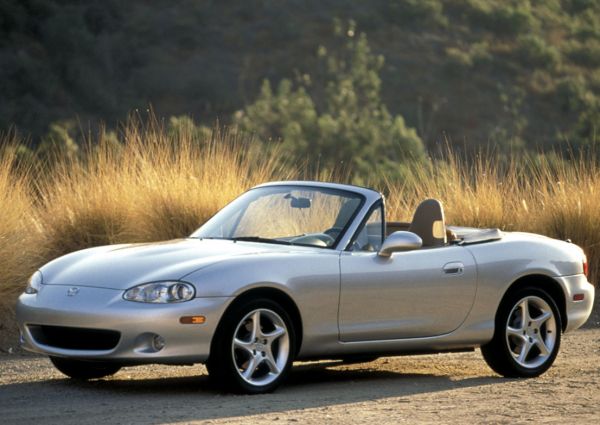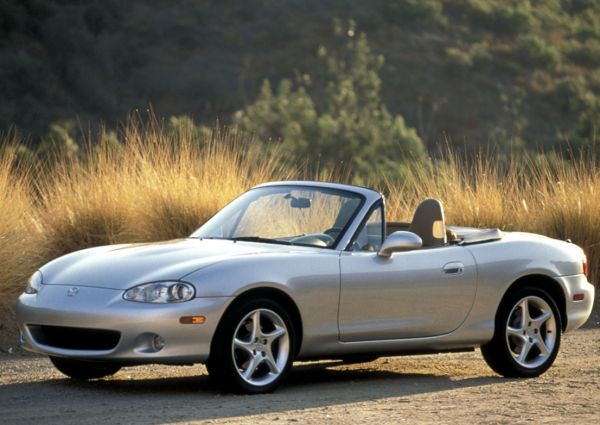The Untold Story of the Mighty Mazda MX-5 Miata
Here’s why you should care about the many iterations of the ingenious little car that could.

Will the person responsible for the Mazda Miata, that devilish little roadster so simple and ingenious that it launched a cult movement 25 years ago, please stand up?
“There are people that say, ‘Oh, you’re the father of the Miata,’” says Bob Hall, the former Mazda product planner. Or, “‘Oh, it’s [designer] Tom Matano’s car.’ It’s actually a guy named Hirai’s car,” Hall says, in a video interview with Jean Jennings, former editor of Automobile Magazine, on her website Jean Knows Cars.
Hall downplays his influence, but he was the guy who originally presented to Mazda the idea of an affordable drop-top in the vein of old Austin Healeys and MGs.
Toshihiko Hirai, on the other hand, took over when Mazda approved the skunkworks sports-car project for production. But that took some convincing over many years. Up until the Miata’s final approval in 1986, it had been Hall’s pipe dream. Were it not for his tireless efforts, the lovable sports car we know today would probably never have materialized.
That’s because in the early ’80s Mazda was considering other proposals for a sporty new two-seater, including one with front-wheel drive and another with a mid-engine layout. But Hall, a journalist by trade who joined Mazda’s California-based research and development operations in 1981, was certain that his vision of a lightweight, affordable roadster in the British tradition (with an engine up front driving the rear wheels) was the way to go. Fortunately, he was able to convince R&D head Kenichi Yamamoto, who in turn persuaded Hall’s boss to let him start working on the project in 1982.
The catch was that Hall had to do it on his own time, when he wasn’t working on the B-Series truck to which he was officially assigned. “Beginning the next day and for seven years, I came in at six in the morning,” he says.
Hall’s relentless fervor—which earned him the nickname Ikigai, a Japanese expression that means “obsession” or “reason for being”—ultimately prevailed, as evidenced by the first Mazda MX-5 Miata that debuted at the 1989 Chicago Auto Show. It would soon reignite America’s interest in roadsters and prompt other automakers to introduce their own.
Generation 1: 1990-1998
The MX-5 Miata was momentous. When it hit the scene in 1989, there was nothing like it. The era of affordable, fun roadsters with lively handling had long passed.
The Miata changed everything, both for the industry, and for Mazda. It is the modern foundation of the “Zoom, Zoom” ethos the company would later introduce in its advertising and which it still uses to this day. Its design and engineering credo was Jinba ittai, a principle of Japanese mounted archery that roughly translates “rider and horse as one body.”
What that means is, engineers set out to make the Mazda MX-5 Miata as compact and light as possible, with an interior that comfortably accommodated two full-size adults. Weight distribution had to be 50/50 front-to-rear, and the suspension a sophisticated “double wishbone” racing design.
The car was (and still is) a blast to drive, despite having a puny four-cylinder engine putting out 115 horsepower. Even for as light as the original Miata was (2,150 pounds), the little four-banger didn’t quite muster enough power to make the car feel fast. A slightly more potent engine came in 1994, but the Miata was never destined to be a speed demon. Rather, it was all about low-speed thrills and affordability.
The design was simple, unadorned, endearing. It took cues from the Lotus Elan of the late ‘60s and early ‘70s, including the gaping lower air intake in the front bumper. From the front, the original Miata looked something like a cartoon car in a Disney movie, with the air intake like a smiling mouth, and the two prominent turn signals on the front—inspired by the Mazda RX-7 sports car—the eyes.
It had pop-up headlights that were of the moment. Pill-shaped taillights with inset circular elements gave a modern interpretation of the traditional round taillights seen on so many sports cars up to that point, from Corvettes to Ferraris.
The MX-5 Miata was an immediate hit, thanks not only to its cute demeanor and playful attitude, but also its affordable price of $13,995 (that’s almost $27,000 in today’s dollars) and reliability—something most convertibles of the day lacked. To manage such a low starting price, Mazda stripped off many features and up-charged for things like power steering and air-conditioning—things that would later become standard.
Generation 2: 1999-2005
Sports-car enthusiasts will remember it like it was yesterday, the great anticipation surrounding Mazda’s second-generation MX-5 Miata. The wait was certainly long enough—almost 10 years.
When the new car finally broke cover at the Tokyo Motor Show in October of 1997, it was clear Mazda chose not to mess with its recipe for success: The next-gen MX-5 Miata was a cautious evolutionary step.
It was a bit wider and carried styling cues of the third-generation RX-7. It was a ’90s car through and through, what with its emphasis on rounded forms and soft shapes. But the biggest design change came with the fixed almond-shape headlights. They weren’t without controversy, but the days of hidden headlights were gone. For one, they didn’t pass new pedestrian impact safety standards. Also, removing their complicated mechanisms saved weight. Considering the new model gained 150 pounds, it needed all the help it could get in that regard.
The interior of the second-generation Miata was, like the exterior, more evolutionary than revolutionary, with the shape of the dash, center console and seats reminiscent of the predecessor’s. One big improvement was the addition of a glass rear window in place of the first-generation’s plastic one.
Performance-wise, the new MX-5 Miata was an improvement in every way: better suspension, better steering, better braking. Engine output was bumped up to 140 horsepower, making the car feel a little peppier, but not much.
A mid-generation facelift for the 2001 model year brought more aggressive styling tweaks. For 2004 and 2005, a turbocharged Mazdaspeed limited edition with 180 horsepower kept enthusiasm going in the waning years of the second generation.
Generation 3: 2005-2015
Mazda changed things up significantly for the third generation of the Miata. Whereas the previous two were closely related in terms of chassis and underpinnings, the latest model was all-new from the ground up.
It was larger and the structure was stiffened, which gave the car more interior space and a better ride. The downside was added weight: The Miata now tipped the scales at 2,447 without options.
Though its lineage was evident in certain details, such as the signature front air intake in the bumper, the styling also changed significantly. The third-generation Miata took on a more monolithic shape as compared to the curvier second-generation design. Its pronounced fender flares payed homage to the RX-8 sports car.
Mazda added the option of an ingenious two-piece folding hardtop. It stowed within the same space as the standard soft top but piled 79 pounds onto the total weight of the vehicle, not to mention $4,695 to the bottom line. Though perhaps a boon in areas with harsh winters, the hardtop did not make the cabin appreciably quieter.
A new four-cylinder engine with slightly larger displacement (2.0 liters versus 1.8, previously) produced 170 horsepower and 140 foot-pounds of torque when paired with the five- or six-speed manual transmission (158 horsepower with the optional six-speed automatic). Finally, the little Miata had a enough power for some decent acceleration (0 to 60 miles per hour in 6.5 seconds).
The 2008 model got a mild freshening, with tweaked front and rear styling and a slight increase in horsepower.
Overall, the third generation feels more grown up than the previous two, with a more sophisticated demeanor, a better ride and added refinement. The price also matured in lockstep: The top Grand Touring trim level with an automatic transmission now exceeds $30,000.
Generation 4: 2016-??
Mazda has made another revolutionary leap with the latest MX-5 Miata. It’s all-new Skyactiv chassis—“Skyactiv” is Mazda marketing-speak for a new generation of lightweight, fuel-saving technology—is roughly the same size as the third-generation’s but is stiffer and lighter, thanks to the use of advanced materials such as ultra-high-strength steel.
Finally, Mazda is reversing the creeping bloat that has plagued pervious generations: The new MX-5 Miata will not be appreciably larger, and it will be more than 200 pounds lighter.
It also looks a lot more aggressive, which was something Mazda discovered Miata fans wanted after conducting market research. Perhaps, the new muscular styling will help change the stigma among certain auto enthusiast circles that the Miata is too feminine.
Regardless, the new design is a big departure, yet does not abandon the roadster’s rich design heritage. The hood is longer and “impossibly low,” says design direct Derek Jenkins during a presentation at the car’s unveiling in Los Angeles. “You can see we brought the nose all the way down, giving the car a lot more confidence and attitude this time around.” The tiny “impossibly slim” LED headlights and larger air inlet in the front bumper enhance the more aggressive look.
The car is a bit wider than before with fenders bulging out proudly, like a bodybuilder flexing his muscles. The windshield has been pushed further back, and the pillars and side mirrors have been painted in black to give an even more “cab rearward” proportion, reminiscent of classic sports cars. The tail of the car tapers dramatically to accentuate the wide fenders.
In keeping with the company’s so-called Kodo design aesthetic, all of the surfaces are “very taut, very lean, trying to the keep the car from looking too puffy,” Jenkins says. “I think that is a big part of what makes the car so contemporary.” Even the taillights have been slimmed down, yet retain the circular element found on previous generations.
On the interior, a lot of effort went into creating a more premium look and feel, with more bright metallic accents, better quality materials and a sleek, minimalist design, which can be seen in the slimness of dashboard and tidy instrument cluster.
Mazda has not released specs on the new Miata, but given how much it has improved other models like the 3 and 6 recently, it will most certainly be better in every way: faster, more agile and more fuel-efficient.
As of July, Mazda had sold more than 940,000 MX-5 Miatas since the roadster’s inception 25 years ago, earning it the Guinness Book of World Record for the best-selling two-seater sports car of all time. With the all-new fourth generation, Mazda is poised to build on that success.

